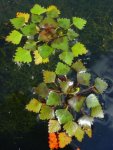Walnut - trapa natans
Family Rogulnikovye - Tgaraseye
Other names: roguel, chilim, fucking nut.
Botanical characteristics. Herbaceous annual plant, may be a perennial. Flexible floating in the water stalk is attached to the bottom, as an anchor, last year's nut, as well as filamentous brownish roots.
When the water level rises, the water nut breaks away from the ground and turns into a freely floating plant. Floating in shallow water and reaching a suitable depth, it again takes root.
First of all, threadlike, early falling leaves appear on the stem. On the water surface, the walnut develops one or more rosettes of rhombic serrated leaves, arranged mosaic due to the different length of the petioles. In the upper part of the petioles there are swellings filled with airy tissue supporting the rosette of the leaves afloat. Flowers are single with white or transparent petals. Blooms in May - June. Fruit is single-seeded, bony-like, black-brown with bent horns. Mature fruits in the silt remain up to 10 years or more, without losing any germination.
Spread. The walnut has a vast geographical area. It grows in stagnant, fresh waters, lakes and starets, sometimes with thickets.
The walnut was known to man since ancient times because of its edible tasty fruits, the core of which contains up to 50% of starch. It was widely used for food. Today cultivated in China, Japan, India. Ancient peoples used a nut in various diseases.
Used parts of the plant. The medicinal raw material is the whole plant, but more often fruits.
Chemical composition. All parts of the plant contain carbohydrates, flavonoids, phenolic compounds, triterpenoids, tannins, vitamins, nitrogenous compounds, mineral salts. In the fruits are found starch, fatty oil, carbohydrates, a large set of vitamins and trace elements.
Application. Nuts are consumed in baked and cooked form. To taste they resemble roasted chestnuts.
In its fresh form it is widely used in Tibetan, Chinese, Japanese medicine for impotence, as a restorative aid after severe illnesses, like diuretic, with kidney diseases, dyspepsia.
In China and India, all parts of the plant are used as an astringent, fixing, tonic, spasmolytic, sedative, diaphoretic, cholagogue.
Fresh juice of leaves and flowers in folk medicine is used to treat eye diseases, as an antiseptic in gonorrhea, whites, various tumors, with snake bites and insects.
In the experiment, a complex of phenolic compounds and carbohydrates, isolated from a water nut, showed the ability to increase the resistance of the organism to unfavorable conditions, exhibits a pronounced antiviral effect.
Preparation
- To get the infusion, take 20 g of leaves and flowers, pour 200 ml of boiling water, insist on a boiling water bath for 15 minutes, cool for 45 minutes, filter. Take 1/3 cup 3 times daily before meals. For external use, increase the concentration by 2-3 times.
- Juice for the treatment of eye diseases must be diluted 1:10. Inside - 30-40 drops per reception 3-4 times a day before meals; For another external application - 1: 3.





Comments
When commenting on, remember that the content and tone of your message can hurt the feelings of real people, show respect and tolerance to your interlocutors even if you do not share their opinion, your behavior in the conditions of freedom of expression and anonymity provided by the Internet, changes Not only virtual, but also the real world. All comments are hidden from the index, spam is controlled.